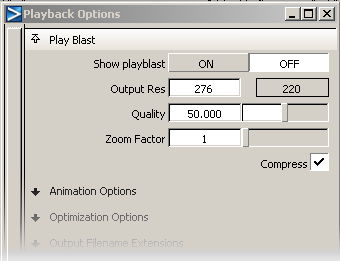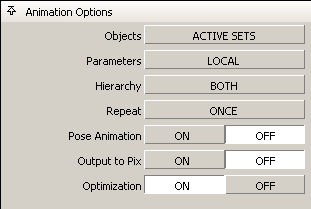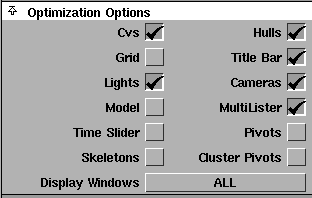Controls animation during playback to optimize playback performance.
See View individual frames of animation.
For example, you can choose to play back only the active items, not display CVs or lights during a playback, or to play back rendered images.
The Playback Options window contains several parameter sections to let you view your animation in different ways.
To open a section, click the black down arrow to the left of the heading.

For more information about play blast, see Use the Play Blast window.

If toggled ON, all animation previews occur in a Play Blast window, and only in this window. To play the animation in the application windows, toggle this option OFF.
Represents the actual screen resolution for the Play Blast window.
If you change the Quality percentage, the Output Res updates to reflect the new resolution of the Play Blast window. If set to 100%, the resolution of the Play Blast window is the same as the active modeling window.
The default for Zoom Factor is 1. If you change it to a large number, the Play Blast window becomes that many times larger than the specified resolution by repeating pixels from the original resolution. For example, if the Zoom Factor is 2, each pixel from the original image is repeated twice (in each direction) to create a larger image.
Determines how the Play Blast images are stored in memory. If the Compress option is toggled ON (indicated by a check mark), the images in memory are compressed. As a general rule, if a large number of frames are being played back, it is a good idea to use this option.

Click to the right of the heading to display the Objects menu.
ALL – Every animated object is animated during a playback.
ACTIVE – Only picked objects are animated during a playback. A DAG node, CV, or camera can be picked using the Pick menu items. A shader, texture, or environment map is active if it is picked in the Multi-lister.
ACTIVE
SETS – Only the items in the selected sets in the Set
Lister are animated during a playback. Choose Animation > Editors > Set Lister  to display the Set Lister.
to display the Set Lister.
Click to the right of the heading to display the Parameters menu.
ALL – All channels of objects are animated during a playback.
GLOBAL/LOCAL – Only channels whose parameters are turned on in the GLOBAL or LOCAL parameter control windows are animated during a playback.
To turn animation parameters
on or off, use Animation > Editors > Param Control  .
.
This menu is only available when either ACTIVE or ACTIVE SETS is chosen from the Objects menu.
None – Keyframes are set only for the selected objects.
Above – Keyframes are set for the selected objects and all objects in the hierarchies above them.
Below – Keyframes are set for the selected objects and all objects in the hierarchies below them.
If Hierarchy is set to Below, and if there is geometry somewhere below a picked DAG node, keyframes are set for all the DAG nodes below the picked DAG node, but not for any of the CVs. To set keyframes for CVs, select the CVs of the geometry you want to animate and set keyframes for them separately.
Both – Includes both Above and Below.
Click to the right of the heading to display the Repeat menu.
ONCE– The range of animation plays back once, then stops.
OSCILLATE– The animation alternates between playing in a forward and reverse direction until you stop the animation.
LOOP– The animation plays over and over in the same direction (in whichever direction the playback was initiated).
If set to ON, playback
only displays the frames in the pose animation sequence. To create
a pose animation sequence, see Animation > Tools > Pose animation  .
.
If set to ON, then the next time a playback is invoked, the animation will be saved to .pix files in the .pix directory of your current project.
You can quickly preview
these images from Animation > Show > FCheck  .
.
The camera view that is used for the images is the same view as the current application window. To specify the window to be used for creating image files, click in it before starting a playback.
After you have entered the name of a file, the playback starts. The first time through the playback, an image file is saved for each frame. After the playback has run once through all the animation in the given range, the Output to Pix option automatically turns OFF, and playback continues without saving image files.
If Optimization is OFF, the playback is not optimized. In this case, the Optimization Options heading is not displayed since it does not apply.
If Optimization is
ON, any playback (invoked from the control panel, from Animation > Show > Playback  , or from the Time Slider)
uses optimization options to increase the speed of the playback.
Expand the Optimization Options section
to set these options.
, or from the Time Slider)
uses optimization options to increase the speed of the playback.
Expand the Optimization Options section
to set these options.

If the Optimization option in the Animation Options window is set to ON, all animation playbacks are optimized using the following optimization options.
If checked, no CVs are displayed during playback.
If checked, no hulls are displayed during playback.
If checked, the grids in the application windows are not displayed during playback.
If checked, the title bar and window icons of the application windows are not displayed during playback.
If checked, no lights are displayed during playback.
If checked, no cameras are displayed during playback.
If checked, no geometry is displayed during playback.
This is useful if a window
is in toggle shade mode (see WindowDisplay > Hardware Shade  ).
).
If checked, shader animation does not occur in the Multi-lister.
If not checked, the animated shader balls are updated at each frame. For a faster playback of just one shader ball, use the animated shader icon next to the shader ball name.
If checked, the time slider and frame counter in the Alias window will not be updated during playback, but will update once playback is over. This optimization alone can double the speed of many Play Blasts, but has minimal effect on most normal playbacks. Note that the frame marker can still be dragged and all of the frame control buttons still operate normally.
If checked, no pivots are rendered during playback.
If checked, skeleton bones are not displayed during playback.
If checked, cluster pivots are not rendered during playback.
 overrides the pivot settings
in the Playback Options Optimization window.
If you have selected WindowDisplay > Toggles > Pivots
overrides the pivot settings
in the Playback Options Optimization window.
If you have selected WindowDisplay > Toggles > Pivots  , no pivots will be rendered
during playback even if you uncheck Pivots or Cluster
Pivots in the Playback Options Optimization window.
, no pivots will be rendered
during playback even if you uncheck Pivots or Cluster
Pivots in the Playback Options Optimization window.
Specifies which windows should remain open during playback. (The more windows that are open, the slower the playback.)
Click to the right of the heading to display the Display Windows menu.
After the playback is finished, all windows that were closed during the playback are reopened.
The Output
Filename Extensions options are used when the Output
to Pix option is set to ON in the Animation
Options window or when you are rendering an animation sequence
with Animation turned ON in Render > Globals  .
.
The names of the image files that will be saved consist of a base name, which the system prompts you for, a period (“.”), and then a numbered extension indicating the place in the sequence of image files that this file represents (for example: filename.1, filename.2, filename.3, and so on.) This number, does not necessarily correspond to the frame number. It is computed using the three options in this window.
This is the number that will be used as the file name extension for the first frame of animation saved to an image file.
This is the amount by which the file name extension number is incremented.
This is the minimum number of digits in the file extension. If the file name extension number has fewer digits than specified by this option, the number is padded with 0's to the left.
For example, assume: